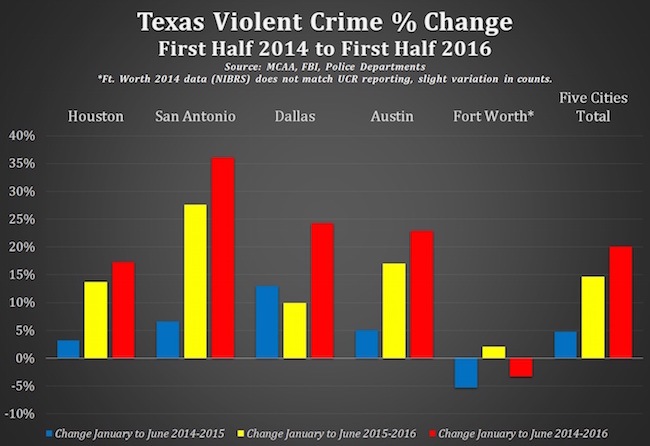Is Texas Wrong on Crime?
Since 2007, when the Lone Star State began to reform its sentencing laws and criminal justice system, advocates for broad criminal justice changes have pointed to Texas as the best example of how both crime and incarceration rates can be reduced.
For several years after the reforms — right through 2014 — crime plummeted as prison populations were reduced. But that trend has been arrested and reversed. Now violent crimes — especially homicide — have spiked again in Texas’ biggest cities.

From the first half of 2014 to the first half of 2016, with the exception of Fort Worth, violent crime in aggregate (murder, rape, robbery, and aggravated assault combined) has risen year-on-year for the first time in a generation.

Last week, Mark Holden of Koch Industries and Ronal Serpas, previously of the Nashville and New Orleans police departments, argued in The Washington Post that pointing to such data, which show downward crime trends reversing, is merely “twist[ing] data and dangerous rhetoric.”
But the data are right there: Crime, particularly murder, is rising faster than population growth in major Texas cities.
To be sure — as I’ve pointed out time and time again — the trend is not uniform (some cities are up a little, others down a lot and vice versa). But the trend, based on FBI statistics from early 2015, is very real: The crime decline has arrested and is reversing.
Holden and Serpas argue that this is only “localized” violence. The problem is that it appears to be localized in America’s biggest cities including Texas.
And New Orleans — where Mr. Serpas once led the police — has recently joined the nation-wide spike in homicides, with a 9 percent jump in 2015 from 2014 lows. The city now has a murder rate that rivals some developing nations.
Nashville, meanwhile, saw murder rates jump 83 percent from 2014 to 2015 — the second biggest increase of the 50 largest cities in the United States — from 41 homicides in 2014 to 75 in 2015. The trend is projected to continue this year.
These are the facts.
It’s true that crime and murder are, thankfully, lower than they were at the 1991 peak. But that’s no excuse for complacency or ignoring facts, just so a political agenda — criminal justice reform — can move forward unimpeded.
Sean Kennedy is a writer and researcher based in Washington, D.C. He previously served as a senate aide, television producer, and fellow at public policy think tanks.
Data is drawn directly from police agencies & Major Cities Chiefs Association reports.
CORRECTION: An earlier version of this article incorrectly calculated 2014 violent crime and homicide figures due to a tabulation error by the author, who deeply regrets the error.




